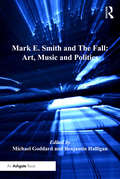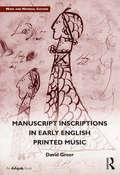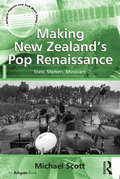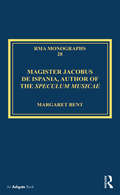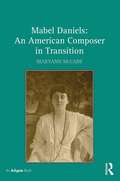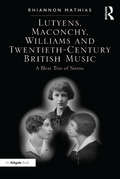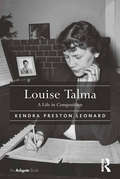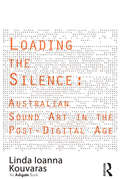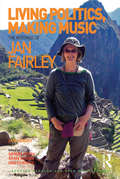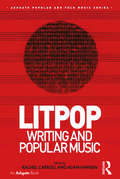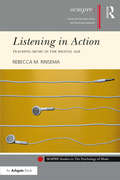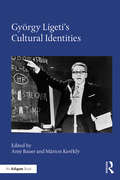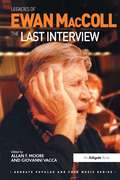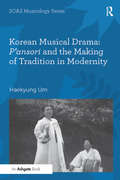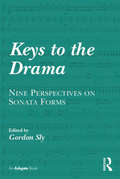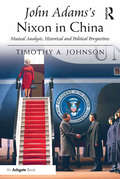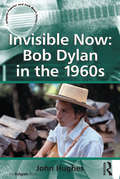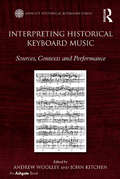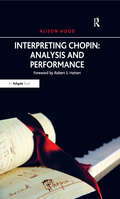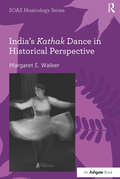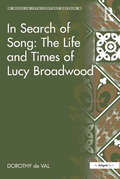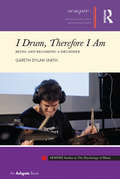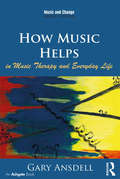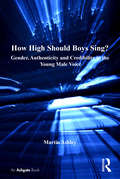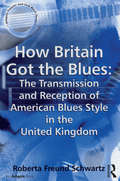- Table View
- List View
Mark E. Smith and The Fall: Art Music And Politics (Ashgate Popular and Folk Music Series)
by Benjamin HalliganThis volume offers a comprehensive range of approaches to the work of Mark E. Smith and his band The Fall in relation to music, art and politics. Mark E. Smith remains one of the most divisive and idiosyncratic figures in popular music after a recording career with The Fall that spans thirty years. Although The Fall were originally associated with the contemporaneous punk explosion, from the beginning they pursued a highly original vision of what was possible in the sphere of popular music. While other punk bands burned out after a few years, only to then reform decades later as their own cover bands, The Fall continue to evolve while retaining a remarkable consistency, even with the frequent line-up changes that soon left Mark E. Smith as the only permanent member of the group. The key aspect of the group that this volume explores is the invariably creative, unfailingly critical and often antagonistic relations that characterize both the internal dynamics of the group and the group's position in the pop cultural surroundings. The Fall's ambiguous position in the unfolding histories of British popular music and therefore in the new heritage industries of popular culture in the UK, from post-punk to anti-Thatcher politics, to the 'Factory fiction of Manchester' and on into Mark E. Smith's current role as ageing enfant terrible of rock, illustrates the uneasy relationship between the band, their critical commentators and the historians of popular music. This volume engages directly with this critical ambiguity. With a diverse range of approaches to The Fall, this volume opens up new possibilities for writing about contemporary music beyond traditional approaches grounded in the sociology of music, Cultural Studies and music journalism - an aim which is reflected in the variety of provocative critical approaches and writing styles that make up the volume.
Manuscript Inscriptions in Early English Printed Music (Music and Material Culture)
by David GreerWho were the first owners of the music published in England in the sixteenth and early seventeenth centuries? Who went to ‘the dwelling house of … T. East, by Paules wharfe’ and bought a copy of Byrd’s Psalmes, sonets, & songs when it appeared in 1588? Who purchased a copy of Dowland’s First booke of songes in 1597? What other books formed part of their music library? In this survey of surviving books of music published before 1640, David Greer has gleaned information about the books’ early and subsequent owners by studying the traces they left in the books themselves: handwritten inscriptions, including names and other marks of ownership - even the scribbles and drawings a child of the family might put into a book left lying about. The result is a treasure trove of information about musical culture in early modern England. From inscriptions and marks of ownership Greer has been able to re-assemble early sets of partbooks, as well as collections of books once bound together. The search has also turned up new music. At a time when paper was expensive, new pieces were copied into blank spaces in printed books. In these jottings we find a ‘hidden repertory’ of music, some of it otherwise undiscovered music by known composers. In other cases, we see owners altering the words of songs, to suit new and personal purposes: a love-song in praise of Daphne becomes a heartfelt song to ‘my Jesus’; and ‘Faire Leonilla’ becomes Ophelia (perhaps the first mention of this character in Hamlet outside the play itself). On a more practical level, the users of the music sometimes made corrections to printing errors, and there are indications that some of these were last-minute corrections made in the printing-house (a useful guide for the modern editor). The temptation to ‘scribble in books’ was as irresistible to some Elizabethans as it is to some of us today. In doing so they left us clues to their identity, how they kept their music, how they used it, and the multifarious ways in which it played a part in their lives.
Making New Zealand's Pop Renaissance: State, Markets, Musicians (Ashgate Popular and Folk Music Series)
by Michael ScottSince the early 2000s New Zealand has undergone a pop renaissance. Domestic artists' sales, airplay and concert attendance have all grown dramatically while new avenues for 'kiwi' pop exports emerged. Concurrent with these trends was a new collective sentiment that embraced and celebrated domestic musicians. In Making New Zealand's Pop Renaissance, Michael Scott argues that this revival arose from state policies and shows how the state built market opportunities for popular musicians through public-private partnerships and organizational affinity with existing music industry institutions. New Zealand offers an instructive case for the ways in which 'after neo-liberal' states steer and co-ordinate popular culture into market exchange by incentivizing cultural production. Scott highlights how these music policies were intended to address various economic and social problems. Arriving with the creative industries' discourse and policy making, politicians claimed these expanded popular music supports would facilitate sustainable employment and a sense of national identity. Yet popular music as economic and social policy presents a paradox: the music industry generates commercial failure and thus requires a large unattached pool of potential talent. Considering this feature, Scott analyses how state programs induced an informal economy of proto-pop production aimed at accessing competitive state funding while simultaneously encouraging musicians to adopt entrepreneurial subjectivities. In doing so he argues New Zealand's music policies are a form of social policy that unintentionally deploy hierarchical structures to foster social inclusion amongst growing numbers of creative workers.
Magister Jacobus de Ispania, Author of the Speculum musicae (Royal Musical Association Monographs)
by Margaret BentThe Speculum musicae of the early fourteenth century, with nearly half a million words, is by a long way the largest medieval treatise on music, and probably the most learned. Only the final two books are about music as commonly understood: the other five invite further work by students of scholastic philosophy, theology and mathematics. For nearly a century, its author has been known as Jacques de Liège or Jacobus Leodiensis. ’Jacobus’ is certain, fixed by an acrostic declared within the text; Liège is hypothetical, based on evidence shown here to be less than secure. The one complete manuscript, Paris BnF lat. 7207, thought by its editor to be Florentine, can now be shown on the basis of its miniatures by Cristoforo Cortese to be from the Veneto, datable c. 1434-40. New documentary evidence in an Italian inventory, also from the Veneto, describes a lost copy of the treatise dating from before 1419, older than the surviving manuscript, and identifies its author as ’Magister Jacobus de Ispania’. If this had been known eighty years ago, the Liège hypothesis would never have taken root. It invites a new look at the geography and influences that played into this central document of medieval music theory. The two new attributes of ’Magister’ and ’de Ispania’ (i.e. a foreigner) prompted an extensive search in published indexes for possible identities. Surprisingly few candidates of this name emerged, and only one in the right date range. It is here suggested that the author of the Speculum is either someone who left no paper trail or James of Spain, a nephew of Eleanor of Castile, wife of King Edward I, whose career is documented mostly in England. He was an illegitimate son of Eleanor’s older half-brother, the Infante Enrique of Castile. Documentary evidence shows that he was a wealthy and well-travelled royal prince who was also an Oxford magister. The book traces his career and the likelihood of his authorship of the Speculum musicae.
Mabel Daniels: An American Composer In Transition
by Maryann McCabeMabel Daniels (1877–1971): An American Composer in Transition assesses Daniels within the context of American music of the first half of the twentieth century. Daniels wrote fresh sounding works that were performed by renowned orchestras and ensembles during her lifetime but her works have only recently begun to be performed again. The book explains why works by Daniels and other women composers fell out of favor and argues for their performance today. This study of Daniels’s life and works evinces transition in women’s roles in composition, the professionalization of women composers, and the role that Daniels played in the institutionalization of American art music. Daniels’s dual role as a patron-composer is unique and expressive of her transitional status.
Lutyens, Maconchy, Williams and Twentieth-Century British Music: A Blest Trio of Sirens
by Rhiannon MathiasElisabeth Lutyens (1906-1983), Elizabeth Maconchy (1907-1994) and Grace Williams (1906-1977) were contemporaries at the Royal College of Music. The three composers' careers were launched with performances in the Macnaghten-Lemare Concerts in the 1930s - a time when, in Britain, as Williams noted, a woman composer was considered 'very odd indeed'. Even so, by the early 1940s all three had made remarkable advances in their work: Lutyens had become the first British composer to use 12-note technique, in her Chamber Concerto No. 1 (1939-40); Maconchy had composed four string quartets of outstanding quality and was busy rethinking the genre; and Williams had won recognition as a composer with great flair for orchestral writing with her Fantasia on Welsh Nursery Tunes (1940) and Sea Sketches (1944). In the following years, Lutyens, Maconchy and Williams went on to compose music of striking quality and to attain prominent positions within the British music scene. Their respective achievements broke through the 'sound ceiling', challenging many of the traditional assumptions which accompanied music by female composers. Rhiannon Mathias traces the development of these three important composers through analysis of selected works. The book draws upon previously unexplored material as well as radio and television interviews with the composers themselves and with their contemporaries. The musical analysis and contextual material lead to a re-evaluation of the composers' positions in the context of twentieth-century British music history.
Louise Talma: A Life in Composition (Cms Monographs And Sourcebooks In American Music Ser.)
by Kendra Preston LeonardAmerican composer Louise Talma (1906-1996) was the first female winner of two back-to-back Guggenheim Awards (1946, 1947), the first American woman to have an opera premiered in Europe (1962), the first female winner of the Sibelius Award for Composition (1963), and the first woman composer elected to the American Academy and Institute of Arts and Letters (1974). This book analyses Talma’s works in the context of her life, focusing on the effects on her work of two major changes she made during her adult life: her conversion to Catholicism as an adult, under the guidance of Nadia Boulanger, and her adoption of serial compositional techniques. Employing approaches from traditional musical analysis, feminist and queer musicology, and women’s autobiographical theory to examine Talma’s body of works, comprising some eighty pieces, this is the first full-length study of this pioneering composer. Exploring Talma’s compositional language, text-setting practices, and the incorporation of autobiographical elements into her works using her own letters, sketches, and scores, as well as a number of other relevant documents, this book positions Talma’s contributions to serial and atonal music in the United States, considers her role as a woman composer during the twentieth century, and evaluates the legacy of her works and career in American music.
Loading the Silence: Australian Sound Art In The Post-digital Age
by Linda Ioanna KouvarasThe experimentalist phenomenon of 'noise' as constituting 'art' in much twentieth-century music (paradoxically) reached its zenith in Cage’s (’silent’ piece) 4’33 . But much post-1970s musical endeavour with an experimentalist telos, collectively known as 'sound art', has displayed a postmodern need to ’load’ modernism’s ’degree zero’. After contextualizing experimentalism from its inception in the early twentieth century, Dr Linda Kouvaras’s Loading the Silence: Australian Sound Art in the Post-Digital Age explores the ways in which selected sound art works demonstrate creatively how sound is embedded within local, national, gendered and historical environments. Taking Australian music as its primary - but not sole - focus, the book not only covers discussions of technological advancement, but also engages with aesthetic standpoints, through numerous interviews, theoretical developments, analysis and cultural milieux for a contemporary Australian, and wider postmodern, context. Developing new methodologies for synergies between musicology and cultural studies, the book uncovers a new post-postmodern aesthetic trajectory, which Kouvaras locates as developing over the past two decades - the altermodern. Australian sound art is here put firmly on the map of international debates about contemporary music, providing a standard reference and valuable resource for practitioners in the artform, music critics, scholars and educators.
Living Politics, Making Music: The Writings of Jan Fairley (Ashgate Popular and Folk Music Series)
by Jan Fairley edited by Frith Ian ChristieThe late Jan Fairley (1949-2012) was a key figure in making world music a significant topic for popular music studies and an influential contributor to such world music magazines as fRoots and Songlines. This book celebrates her contribution to popular music scholarship by gathering her most important work together in a single place. The result is a richly informed and entertaining volume that will be of interest to all scholars in the field while also serving as an excellent introduction for students interested in popular music as a global phenomenon. Fairley’s work was focused on the problems and possibilities of cross-cultural musical influences, fantasies and flows and on the importance of performing circuits and networks. Her interest in the details of music-making and in the lives of music-makers means that this collection is also an original and illuminating study of music and politics. In drawing on Jan Fairley’s journalism, this volume also offers students a guide to various genres of world music, from Cuban son to flamenco, as well as an insight into the lives of such world music stars as Mercedes Sosa and Silvio RodrÃguez. This is inspiring as well as essential reading.
Litpop: Writing And Popular Music (Ashgate Popular and Folk Music Series)
by Adam Hansen Rachel CarrollBringing together exciting new interdisciplinary work from emerging and established scholars in the UK and beyond, Litpop addresses the question: how has writing past and present been influenced by popular music, and vice versa? Contributions explore how various forms of writing have had a crucial role to play in making popular music what it is, and how popular music informs ’literary’ writing in diverse ways. The collection features musicologists, literary critics, experts in cultural studies, and creative writers, organised in three themed sections. ’Making Litpop’ explores how hybrids of writing and popular music have been created by musicians and authors. ’Thinking Litpop’ considers what critical or intellectual frameworks help us to understand these hybrid cultural forms. Finally, ’Consuming Litpop’ examines how writers deal with music’s influence, how musicians engage with literary texts, and how audiences of music and writing understand their own role in making ’Litpop’ happen. Discussing a range of genres and periods of writing and popular music, this unique collection identifies, theorizes, and problematises connections between different forms of expression, making a vital contribution to popular musicology, and literary and cultural studies.
Listening in Action: Teaching Music in the Digital Age (SEMPRE Studies in The Psychology of Music)
by Rebecca M RinsemaIn an age when students come to class with more varied music listening preferences and experiences than ever before, music educators can find themselves at a loss for how to connect with their students. Listening in Action provides the beginnings of a solution to this problem by characterizing students’ contemporary music listening experiences as they are mediated by digital technologies. Several components of contemporary music listening experiences are described, including: the relationship between music listening experiences and listener engagements with other activities; listener agency in creating playlists and listening experiences as a whole; and the development of adolescent identities as related to the agency afforded by music listening devices. The book provides an accessible introduction to scholarship on music listening across the disciplines of musicology, ethnomusicology, sociology of music, psychology of music, and music education. By reading Listening in Action, music educators can gain an understanding of recent theories of music listening in everyday life and how those theories might be applied to bridge the gap between music pedagogies and students who encounter music in a heavily mediated, postperformance world.
György Ligeti's Cultural Identities
by Amy Bauer Márton KerékfySince György Ligeti’s death in 2006, there has been a growing acknowledgement of how central he was to the late twentieth-century cultural landscape. This collection is the first book devoted to exploring the composer’s life and music within the context of his East European roots, revealing his dual identities as both Hungarian national and cosmopolitan modernist. Contributors explore the artistic and socio-cultural contexts of Ligeti’s early works, including composition and music theory, the influence of East European folk music, notions of home and identity, his ambivalent attitude to his Hungarian past and his references to his homeland in his later music. Many of the valuable insights offered profit from new research undertaken at the Paul Sacher Foundation, Basel, while also drawing on the knowledge of long-time associates such as the composer’s assistant, Louise Duchesneau. The contributions as a whole reveal Ligeti’s thoroughly cosmopolitan milieu and values, and illuminate why his music continues to inspire new generations of performers, composers and listeners.
Legacies of Ewan MacColl: The Last Interview (Ashgate Popular and Folk Music Series)
by Giovanni VaccaEwan MacColl is widely recognized as a key figure in the English folk revival, who tried to convey traditional music to a mass audience. Dominant in the movement during the 1950s and much of the 1960s, his position has come under attack in more recent years from some scholars. While it would be arrogant to claim to 'set the record straight', this book will contribute significantly to the debate surrounding MacColl's importance. MacColl gave two extended interviews with co-editor Giovanni Vacca in 1987 and 1988, not long before his death, and these provide the impetus for a re-examination of his methods, his politics and his aesthetic aims. The book also provides critical overviews of MacColl's activities in the revival and of his practices, particularly as writer and singer. The time is ripe for such a contribution, following Peter Cox's study of the Radio Ballads, and in the context of biographies by Joan Littlewood and Frankie Armstrong. The contributions locate MacColl in his own historical context, attempting to understand some of the characteristic techniques through which he was able to write and sing such extraordinary songs, which capture so well for others the detail and flavour of their lives. Great emphasis is placed on the importance of seeing MacColl as not only a British, but a European folk activist, through discussion of his hitherto barely known work in Italy, enabling a re-contextualization of his work within a broader European context. The interviews themselves are fluent and fascinating narrations in which MacColl discusses his life, music, and experiences in the theatre and in the folk music revival as well as with a series of issues concerning folk music, politics, history, language, art and other theoretical issues, offering a complete description of all the repertories of the British Isles. Peggy Seeger contributes a Foreword to the collection.
Korean Musical Drama: P'ansori And The Making Of Tradition In Modernity (SOAS Studies in Music)
by Haekyung UmP’ansori is the quintessential traditional Korean musical drama, in which epic tales are sung and narrated by a solo singer accompanied by a drummer. Drawing on her extensive research in Korea and its diasporas, Haekyung Um describes and analyses the creative processes of p’ansori, weaving into her discussion musical, social and cultural aspects that include the evolution of p’ansori performance, origins and historical development, textual and musical materials, stylistic features of different p’ansori schools, transmission of knowledge, aesthetics, and changing interpretations of tradition. Also explored is the complexity of historical and contemporary influences that give shape to p’ansori as a ’living tradition’ across the ages and into the present, and as a cultural icon with an enduring narrative and emotional impact. Social, economic and political dynamics are created in the nexus of traditional feudal values, colonial modernity and nationalism. The impact of aspects of late modernity such as technology, mass media, migration and globalization, has transported p’ansori into digital and transnational domains. By bringing all these creative and contextual processes together, Haekyung Um explains how a tradition is created, maintained and redefined by the dynamic interactions of agents, values, meanings, strategies, identities and artistic hybridity.
Keys to the Drama: Nine Perspectives on Sonata Forms
by Gordon SlySonata form is fundamentally a dramatic structure that creates, manipulates, and ultimately satisfies expectation. It engages its audience by inviting prediction, association, and interpretation. That sonata form was the chief vehicle of dramatic instrumental music for nearly 200 years is due to the power, the universality, and the tonal and stylistic adaptability of its conception. This book presents nine studies whose central focus is sonata form. Their diversity attests both to the manifold analytical approaches to which the form responds, and to the vast range of musical possibility within the form's exemplars. At the same time, common compositional issues, analytical methods, and overarching perspectives on the essential nature of the form weave their way through the volume. Several of the essays approach the musical structure directly as drama, casting the work as an expression of its composer's engagement with an idea or principle that is dynamic and at times intensely difficult. Others concentrate their attention on a composer's use of "motive," which typically takes the form of a simple melodic span that shapes the musical architecture through an interdependent series of structural levels. Integrating these motivic threads within the musical fabric often warrants departures from formal norms in other areas. Analyses that seek to understand works with anomalous formal qualities-whether engendered by a motivic component or not-have a prominent place in the volume. Among these, accounts of idiosyncratic tonal discourse that threatens to undermine the unfolding of form-defining qualities or events are central.
John Adams's Nixon in China: Musical Analysis, Historical and Political Perspectives
by Timothy A. JohnsonJohn Adams's opera, Nixon in China, is one of the most frequently performed operas in the contemporary literature. Timothy A. Johnson illuminates the opera and enhances listeners' and scholars' appreciation for this landmark work. This music-analytical guide presents a detailed, in-depth analysis of the music tied to historical and political contexts. The opera captures an important moment in history and in international relations, and a close study of it from an interdisciplinary perspective provides fresh, compelling insights about the opera. The music analysis takes a neo-Riemannian approach to harmony and to large-scale harmonic connections. Musical metaphors drawn between harmonies and their dramatic contexts enrich this approach. Motivic analysis reveals interweaving associations between the characters, based on melodic content. Analysis of rhythm and meter focuses on Adams's frequent use of grouping and displacement dissonances to propel the music forward or to illustrate the libretto. The book shows how the historical depiction in the opera is accurate, yet enriched by this operatic adaptation. The language of the opera is true to its source, but more evocative than the words spoken in 1972-due to Alice Goodman's marvelous, poetic libretto. And the music transcends its repetitive shell to become a hierarchically-rich and musically-compelling achievement.
Invisible Now: Bob Dylan In The 1960s (Ashgate Popular and Folk Music Series)
by John HughesInvisible Now describes Bob Dylan's transformative inspiration as artist and cultural figure in the 1960s. Hughes identifies Dylan's creativity with an essential imaginative dynamic, as the singer perpetually departs from a former state of inexpression in pursuit of new, as yet unknown, powers of self-renewal. This motif of temporal self-division is taken as corresponding to what Dylan later referred to as an artistic project of 'continual becoming', and is explored in the book as a creative and ethical principle that underlies many facets of Dylan's appeal. Accordingly, the book combines close discussions of Dylan's mercurial art with related discussions of his humour, voice, photographs, and self-presentation, as well as with the singularities of particular performances. The result is a nuanced account of Dylan's creativity that allows us to understand more closely the nature of Dylan's art, and its links with American culture.
Interpreting Historical Keyboard Music: Sources, Contexts and Performance (Ashgate Historical Keyboard Series)
by Andrew Woolley John KitchenResearch in the field of keyboard studies, especially when intimately connected with issues of performance, is often concerned with the immediate working environments and practices of musicians of the past. An important pedagogical tool, the keyboard has served as the ’workbench’ of countless musicians over the centuries. In the process it has shaped the ways in which many historical musicians achieved their aspirations and went about meeting creative challenges. In recent decades interest has turned towards a contextualized understanding of creative processes in music, and keyboard studies appears well placed to contribute to the exploration of this wider concern. The nineteen essays collected here encompass the range of research in the field, bringing together contributions from performers, organologists and music historians. Questions relevant to issues of creative practice in various historical contexts, and of interpretative issues faced today, form a guiding thread. Its scope is wide-ranging, with contributions covering the mid-sixteenth to early twentieth century. It is also inclusive, encompassing the diverse range of approaches to the field of contemporary keyboard studies. Collectively the essays form a survey of the ways in which the study of keyboard performance can enrich our understanding of musical life in a given period.
Interpreting Chopin: Analysis and Performance
by Alison HoodMusic theory is often seen as independent from - even antithetical to - performance. While music theory is an intellectual enterprise, performance requires an intuitive response to the music. But this binary opposition is a false one, which serves neither the theorist nor the performer. In Interpreting Chopin Alison Hood brings her experience as a performer to bear on contemporary analytical models. She combines significant aspects of current analytical approaches and applies that unique synthetic method to selected works by Chopin, casting new light on the composer’s preludes, nocturnes and barcarolle. An extension of Schenkerian analysis, the specific combination of five aspects distinguishes Hood’s method from previous analytical approaches. These five methods are: attention to the rhythms created by pitch events on all structural levels; a detailed accounting of the musical surface; 'strict use' of analytical notation, following guidelines offered by Steve Larson; a continual concern with what have been called 'strategies' or 'premises'; and an exploration of how recorded performances might be viewed in terms of analytical decisions, or might even shape those decisions. Building on the work of such authors as William Rothstein, Carl Schachter and John Rink, Hood’s approach to Chopin’s oeuvre raises interpretive questions of central interest to performers.
India's Kathak Dance in Historical Perspective (SOAS Studies in Music)
by Margaret E. WalkerKathak, the classical dance of North India, combines virtuosic footwork and dazzling spins with subtle pantomime and soft gestures. As a global practice and one of India's cultural markers, kathak dance is often presented as heir to an ancient Hindu devotional tradition in which men called Kathakas danced and told stories in temples. The dance's repertoire and movement vocabulary, however, tell a different story of syncretic origins and hybrid history - it is a dance that is both Muslim and Hindu, both devotional and entertaining, and both male and female. Kathak's multiple roots can be found in rural theatre, embodied rhythmic repertoire, and courtesan performance practice, and its history is inextricable from the history of empire, colonialism, and independence in India. Through an analysis both broad and deep of primary and secondary sources, ethnography, iconography and current performance practice, Margaret Walker undertakes a critical approach to the history of kathak dance and presents new data about hereditary performing artists, gendered contexts and practices, and postcolonial cultural reclamation. The account that emerges places kathak and the Kathaks firmly into the living context of North Indian performing arts.
In Search of Song: The Life And Times Of Lucy Broadwood (Music in Nineteenth-Century Britain)
by Dorothy de ValBorn into the famous family of piano makers, Lucy Broadwood (1858-1929) became one of the chief collectors and scholars of the first English folk music revival in the late nineteenth and early twentieth centuries. Privately educated and trained as a classical musician and singer, she was inspired by her uncle to collect local song from her native Sussex. The desire to rescue folk song from an aging population led to the foundation of the Folk Song Society, of which she was a founder member. Mentor to younger collectors such as Percy Grainger but often at loggerheads with fellow collector Cecil Sharp and the young Ralph Vaughan Williams, she eventually ventured into Ireland and Scotland, while remaining an eclectic contributor and editor of the Society’s Journal, which became a flagship for scholarly publication of folksong. She also published arrangements of folk songs and her own compositions which attracted the attention of singers such as Harry Plunket Greene. Using an array of primary sources including the diaries Broadwood kept throughout her adult life, Dorothy de Val provides a lively biography which sheds new light on her early years and chronicles her later busy social, artistic and musical life while acknowledging the underlying vulnerability of single women at this time. Her account reveals an intelligent, generous though reserved woman who, with the help of her friends, emerged from the constraints of a Victorian upbringing to meet the challenges of the modern world.
I Drum, Therefore I Am: Being and Becoming a Drummer (SEMPRE Studies in The Psychology of Music)
by Gareth Dylan SmithDespite their central role in many forms of music-making, drummers have been largely neglected in the scholarly literature on music and education. But kit drummers are increasingly difficult to ignore. While exponents of the drum kit are frequently mocked in popular culture, they are also widely acknowledged to be central to the musical success and aesthetic appeal of any musical ensemble in which they are found. Drummers are also making their presence felt in music education, with increasing opportunities to learn their craft in formal contexts. Drawing on data collected from in-depth interviews and questionnaires, Gareth Dylan Smith explores the identities, practices and learning of teenage and adult kit drummers in and around London. As a London-based drummer and teacher of drummers, Smith uses his own identity as participant-researcher to inform and interpret other drummers' accounts of their experiences. Drummers learn in multi-modal ways, usually with a keen awareness of exemplars of their art and craft. The world of kit drumming is highly masculine, which presents opportunities and challenges to drummers of both sexes. Smith proposes a new model of the 'Snowball Self', which incorporates the constructs of identity realization, learning realization, meta-identities and contextual identities. Kit drummers' identities, practices and learning are found to be intertwined, as drummers exist in a web of interdependence. Drummers drum; therefore they are, they do, and they learn - in a rich tapestry of means and contexts.
How Music Helps in Music Therapy and Everyday Life (Music and Change: Ecological Perspectives)
by Gary AnsdellWhy is music so important to most of us? How does music help us both in our everyday lives, and in the more specialist context of music therapy? This book suggests a new way of approaching these topical questions, drawing from Ansdell's long experience as a music therapist, and from the latest thinking on music in everyday life. Vibrant and moving examples from music therapy situations are twinned with the stories of 'ordinary' people who describe how music helps them within their everyday lives. Together this complementary material leads Ansdell to present a new interdisciplinary framework showing how musical experiences can help all of us build and negotiate identities, make intimate non-verbal relationships, belong together in community, and find moments of transcendence and meaning. How Music Helps is not just a book about music therapy. It has the more ambitious aim to promote (from a music therapist's perspective) a better understanding of 'music and change' in our personal and social life. Ansdell's theoretical synthesis links the tradition of Nordoff-Robbins music therapy and its recent developments in Community Music Therapy to contemporary music sociology and music studies. This book will be relevant to practitioners, academics, and researchers looking for a broad-based theoretical perspective to guide further study and policy in music, well-being, and health.
How High Should Boys Sing?: Gender, Authenticity and Credibility in the Young Male Voice
by Martin Ashley'A boy sings...a beautiful thing' (www.boychoirs.org), but is it? What kinds of boy, singing what kinds of music and to whom? Martin Ashley presents a unique consideration of boys' singing that shows the high voice to be historically, culturally and physiologically more problematic even than is commonly assumed. Through Ashley's extensive conversations with young performers and analysis of their reception by 'peer audiences', the research reveals that the common supposition that 'boys don't want to sound like girls' is far from adequate in explaining the 'missing males' syndrome that can perplex choir directors. The book intertwines the study of singing with the study of identity to create a rich resource for musicians, scholars, teachers and all those concerned with young male involvement in music through singing. The conclusions of the book will challenge many attitudes and unconsidered positions through its argument that many boys actually want to sing but are discouraged by a failure of the adult world to understand the boy mind. Ashley intends the book to stand as an indictment of much complacency and myopia with regard to the young male voice. A substantial grant from the Arts and Humanities Research Council has enabled the production of a multi-media resource for schools, choirs and youth organizations called Boys Keep Singing. Based on the contents of this book, the resource shows how, once the interest of boys is captured in primary schools, their singing can be sustained and developed through the difficult but vital early secondary years of ages 11 - 14, about which this book says so much. The resource is lavishly illustrated by short films of boys singing, supported by interviews with boys and their teachers, and a wealth of of animated diagrams and cartoons. It is available to schools and organizations involved in musical education through registration at www.boys-keep-singing.com.
How Britain Got the Blues: The Transmission And Reception Of American Blues Style In The United Kingdom (Ashgate Popular and Folk Music Series)
by Roberta Freund SchwartzThis book explores how, and why, the blues became a central component of English popular music in the 1960s. It is commonly known that many 'British invasion' rock bands were heavily influenced by Chicago and Delta blues styles. But how, exactly, did Britain get the blues? Blues records by African American artists were released in the United States in substantial numbers between 1920 and the late 1930s, but were sold primarily to black consumers in large urban centres and the rural south. How, then, in an era before globalization, when multinational record releases were rare, did English teenagers in the early 1960s encounter the music of Robert Johnson, Blind Boy Fuller, Memphis Minnie, and Barbecue Bob? Roberta Schwartz analyses the transmission of blues records to England, from the first recordings to hit English shores to the end of the sixties. How did the blues, largely banned from the BBC until the mid 1960s, become popular enough to create a demand for re-released material by American artists? When did the British blues subculture begin, and how did it develop? Most significantly, how did the music become a part of the popular consciousness, and how did it change music and expectations? The way that the blues, and various blues styles, were received by critics is a central concern of the book, as their writings greatly affected which artists and recordings were distributed and reified, particularly in the early years of the revival. 'Hot' cultural issues such as authenticity, assimilation, appropriation, and cultural transgression were also part of the revival; these topics and more were interrogated in music periodicals by critics and fans alike, even as English musicians began incorporating elements of the blues into their common musical language. The vinyl record itself, under-represented in previous studies, plays a major part in the story of the blues in Britain. Not only did recordings shape perceptions and listening habits, but which artists were available at any given time also had an enormous impact on the British blues. Schwartz maps the influences on British blues and blues-rock performers and thereby illuminates the stylistic evolution of many genres of British popular music.
